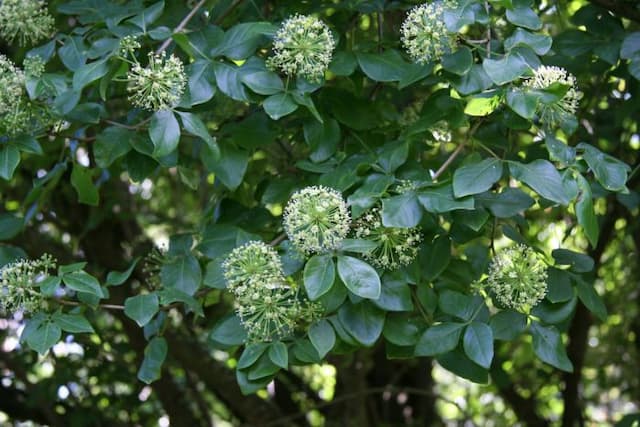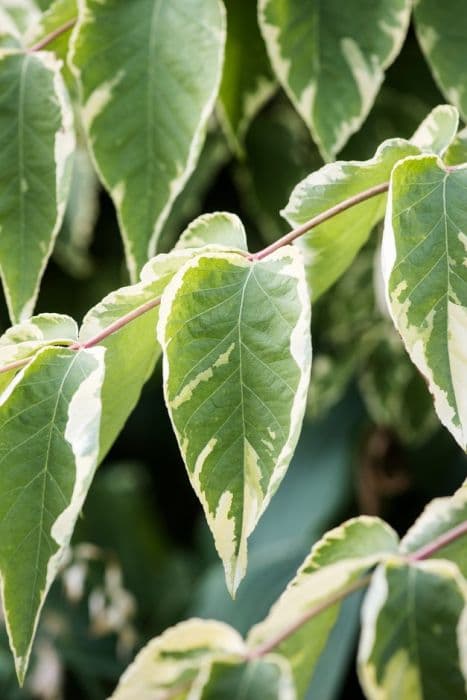Chinese aralia Metapanax davidii

ABOUT
Metapanax davidii, commonly known as David's mountain-holly, is a distinctive plant with a bushy, multi-stemmed appearance. The leaves of David's mountain-holly are typically compound, meaning that each leaf is comprised of several smaller leaflets arranged on either side of a central stem, a structure that resembles a feather. These leaflets are generally broad with pointed tips, creating an overall shape that is somewhat elongated with a serrated or toothed edge. The overall foliage of the plant gives a lush, dense impression, and the leaves present a glossy green color that can add a vibrant touch to the plant's surroundings. During its flowering season, David's mountain-holly produces clusters of small, inconspicuous flowers. These flowers may be followed by tiny fruits that could add an additional layer of visual interest. The bark of the plant is typically a smooth to slightly textured surface with a color that can vary depending on the age and environmental conditions of the shrub. Overall, the appearance of David's mountain-holly makes it an attractive choice for many gardeners looking for a plant with a lush and textured presence without taking up an excessive amount of space with its breadth.
About this plant
 Names
NamesSynonyms
David's Metapanax, Metapanax.
Common names
Metapanax delavayi
 Toxicity
ToxicityTo humans
Metapanax davidii, commonly known as David's metapanax, has no well-documented evidence of toxicity to humans. However, due to the general lack of extensive research on this specific species, it is typically advisable to avoid ingesting plants not known to be safe. If any part of this plant were to be toxic, potential symptoms could include gastrointestinal upset such as nausea, vomiting, or diarrhea, as well as possible allergic reactions. Without specific research on the toxicity of David's metapanax to humans, it's important to handle any unfamiliar plant with caution and to consult a medical professional if ingestion occurs and adverse symptoms appear.
To pets
David's metapanax does not have a well-established record of toxicity in pets either. Similar to the precautions for humans, due to the lack of specific information regarding its safety, it is best to prevent pets from ingesting any parts of the plant. If David's metapanax were poisonous, pets might exhibit symptoms like vomiting, diarrhea, excessive drooling, or signs of oral irritation. In the absence of detailed toxicology data for pets, it is always a good practice to keep houseplants and garden plants out of reach of animals and to consult with a veterinarian if accidental ingestion occurs.
 Characteristics
CharacteristicsLife cycle
Perennials
Foliage type
Deciduous
Color of leaves
Green
Flower color
Varies
Height
10 feet (3 meters)
Spread
6 feet (1.8 meters)
Plant type
Shrub
Hardiness zones
7
Native area
China
Benefits
 General Benefits
General Benefits- Landscape aesthetics: Metapanax davidii, also known as the Shieldleaf Roger's Flower, is often used in landscape design for its attractive foliage and architectural presence.
- Wildlife habitat: The plant can provide shelter and food for various species of wildlife, including birds and beneficial insects.
- Soil stabilization: With its root system, the Shieldleaf Roger's Flower can help to stabilize soil and prevent erosion in certain environments.
- Shade provision: Larger specimens can offer shade in gardens, which can help to cool surrounding areas and provide a comfortable outdoor environment.
- Cultural significance: In some regions, it may have cultural importance and be used in traditional practices or ceremonies.
- Education and research: As a species with particular characteristics, it can be a subject of study for educational purposes or scientific research.
 Medical Properties
Medical Properties- Anti-inflammatory: Metapanax davidii is believed to have anti-inflammatory effects, which could help reduce swelling and pain in various conditions.
- Immune system modulation: It may have properties that modulate the immune system, potentially aiding in the body's defense mechanisms.
- Antioxidant: The plant is said to contain antioxidants that protect the body from damage caused by free radicals.
- Antitumor activity: Compounds in Metapanax davidii might have antitumor properties, potentially making it useful in cancer research.
- Antimicrobial: Some studies suggest that Metapanax davidii may have antimicrobial effects against certain pathogens.
 Air-purifying Qualities
Air-purifying QualitiesThis plant is not specifically known for air purifying qualities.
 Other Uses
Other Uses- Metapanax davidii, commonly known as David's metapanax, can be cultivated as an ornamental plant for its attractive foliage and structure.
- In garden landscapes, David's metapanax may be used as a privacy screen due to its dense growth habit.
- This plant can serve as a habitat for bird species, providing shelter and nesting opportunities within its branches.
- David's metapanax might be incorporated into permaculture designs as a structural element due to its hardiness and perennial nature.
- Certain communities might utilize the wood of David's metapanax for crafting small items or tools, though this is not a primary use.
- The dried seeds or fruits could potentially be used in decorative crafts or as part of homemade potpourri mixes.
- In some cultures, the leaves could be used in floral arrangements or as greenery in displays due to their distinctive shape.
- Gardeners might propagate David's metapanax as a form of living fence, training and trimming the plant to create a natural boundary.
- The plant can contribute to soil stabilization efforts in landscaping projects, thanks to its robust root system.
- David's metapanax leaves might be employed as a natural mulch or compost material after they have fallen, adding nutrients back into the soil.
Interesting Facts
 Feng Shui
Feng ShuiThe Metapanax davidii is not used in Feng Shui practice.
 Zodiac Sign Compitability
Zodiac Sign CompitabilityThe Metapanax davidii is not used in astrology practice.
 Plant Symbolism
Plant Symbolism- Resilience: Metapanax davidii, also known as the David's metapanax, is known for its hardiness and ability to thrive in various conditions, symbolizing resilience and adaptability in the face of adversity.
- Growth: As a plant that grows and evolves over time, the David's metapanax represents personal or spiritual growth and the potential for continuous development.
- Protection: Often found in traditional gardens, the David's metapanax is deemed a symbol of protection, providing a shield against negative influences and fostering a safe environment.
 Water
WaterThe Metapanax davidii, commonly known as the David's Tree Ivy, requires regular watering to maintain moist but not soggy soil. During the growing season in spring and summer, water it once every week with around 16-24 ounces of water. In fall and winter, reduce watering to every two weeks, adjusting the amount of water according to the humidity and temperature of your environment. Always check the topsoil before watering; if the top inch is dry, it's time to water. Avoid overwatering as it can lead to root rot.
 Light
LightDavid's Tree Ivy thrives best in bright, indirect light. Place it near a window where it can receive plenty of light but is shielded from the direct rays of the sun, which can scorch its leaves. An east or north-facing window is typically a good spot for this plant. If the light is too low, the growth may become leggy.
 Temperature
TemperatureDavid's Tree Ivy prefers temperatures between 60-75 degrees Fahrenheit and should not be exposed to temperatures below 50 degrees Fahrenheit as it can damage the plant. The ideal temperature range allows the plant to grow robustly. Ensure protection from drafts and sudden temperature changes to maintain its health.
 Pruning
PruningPruning David's Tree Ivy is essential to maintain its shape and encourage bushier growth. Prune the plant in the early spring before the new growth starts. Snip off any dead or leggy branches to promote new shoots. Pruning can be done every year or as needed when the plant appears overgrown or unkempt.
 Cleaning
CleaningAs needed
 Soil
SoilMetapanax davidii, commonly known as Elderberry Panax, thrives best in a well-draining soil mix with high organic content. An ideal soil blend for this plant might include loamy garden soil, peat, and perlite in equal parts to ensure good aeration and moisture retention. The soil pH should be slightly acidic to neutral, ranging from 6.0 to 7.0 for optimal growth.
 Repotting
RepottingElderberry Panax should be repotted every 2-3 years to ensure it continues to thrive. Young plants may require more frequent repotting, every 1-2 years, as they grow more quickly and can become root-bound. When repotting, it's crucial to use a suitable soil mix and a pot that's slightly larger than the previous one.
 Humidity & Misting
Humidity & MistingElderberry Panax prefers a humid environment, with the ideal humidity level being around 60-75% for optimal growth. It is important to maintain this humidity level, especially during drier winter months which may require additional humidity through the use of humidifiers or pebble trays.
 Suitable locations
Suitable locationsIndoor
Place Elderberry Panax in bright, indirect light and keep humid.
Outdoor
Plant in partial shade, protect from strong winds, keep soil moist.
Hardiness zone
7-10 USDA
 Life cycle
Life cycleMetapanax davidii, commonly known as Metapanax, begins its life cycle as a seed that germinates in moist and shaded soil typically found in woodland areas where the plant is native. After germination, it enters the seedling stage where its first leaves, or cotyledons, emerge and it begins to photosynthesize. As the seedling grows, it develops into a juvenile plant with a more established root system and a true set of leaves characteristic of Metapanax davidii. During its adult stage, the plant becomes mature and capable of flowering and fruiting, producing clusters of small, usually whitish flowers that are followed by berry-like fruits when pollinated. These fruits contain seeds that, once dispersed by wildlife or gravity, can start a new life cycle if they land in favorable conditions. Metapanax davidii is a perennial, which means it can live for several years, going through recurring seasonal growth cycles and reaching a considerable size as a shrub or small tree.
 Propogation
PropogationPropogation time
Spring-Early Summer
Propogation: Metapanax davidii, commonly known as David's metapanax, is best propagated through semi-hardwood cuttings. This method is popular as it can reliably produce new plants that are clones of the parent. To propagate, cuttings of 4-6 inches (10-15 cm) should be taken from healthy, mature plants during late summer. The cut ends of the cuttings are then dipped into a rooting hormone to encourage root development and planted in a well-draining potting mix. The environment should be kept humid, and the soil should maintain consistent moisture without becoming waterlogged. With proper care, the cuttings will begin to establish roots within a few weeks, at which point they can be gradually acclimated to less humid conditions before being transplanted to their permanent location.









